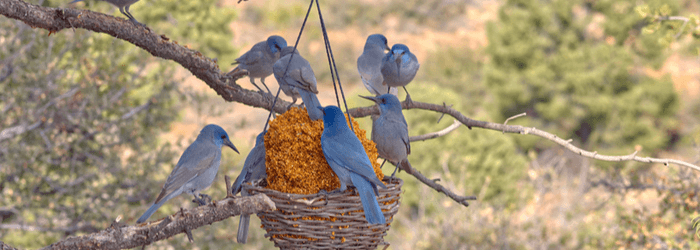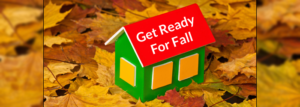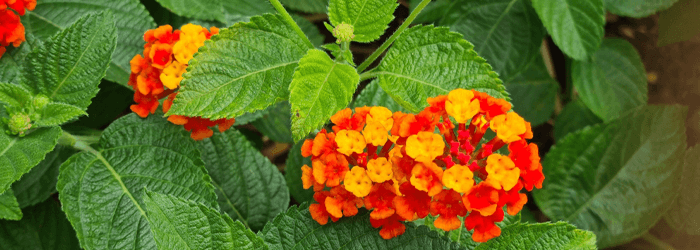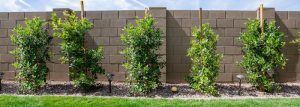Thinking about livening up your backyard? Want to attract wildlife and birds? Now that fall is approaching, start planning your backyard habitat and enjoy the birds, butterflies, and lizards that pop by for a visit.
If You Build It . . .
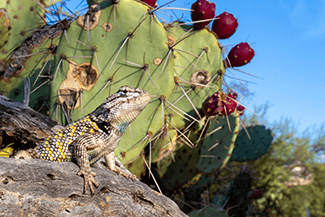
Building a backyard habitat can be as simple and inexpensive as you want it to be. The key is to select native and desert-adapted plants and trees that provide a lush and colorful landscape every season with very little water. With input from Kathleen Ferris, AMWUA, follow these guidelines to create a backyard habitat.
Shelter:
Diversity is important. Migratory and native birds need high and low places to hide, to rest, and to nest. They look for tall cactus, tall shrubs, and trees. Quail and lizards like ground cover. They look for vines, low shrubs, and cactus in groupings where it is easy to hide from predators and find shade. Yet, they also need open spaces in between groupings of plants to hunt for seeds and insects.
Leaping lizards! Attract those push-up show-offs to your yard. Lizards are nature’s insect exterminators. They dine on insects, spiders, scorpions, and sometimes other lizards. Lizards need places to forage, bask, hibernate, and breed. Rock piles and native plants such as prickly pear cactus, desert spoon, and cholla cactus work well. The Arizona Native Plant Society has tips to make your yard lizard friendly. The Tucson Herpetological Society has a lot of information on lizard species. Note: keep your distance if a Gila monster make an appearance. The Gila monster has powerful jaws. Admire from a distance.
Maintenance:
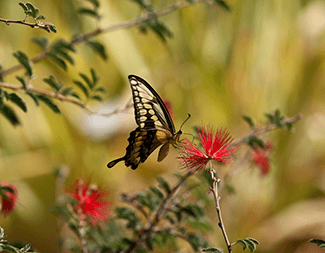
An impeccable garden won’t attract much wildlife. Birds are attracted to insects under leaves and seeds shed by plants and trees. Don’t be eager to rake up what you think is a mess. Also, keep pruning to a minimum. Over pruning or shearing will remove flowers, seeds, and berries that birds and butterflies seek. A shrub sheared into a ball or triangle does not provide lower branches to shelter birds or lizards. Many Arizona cities have demonstration gardens where you can see how shrubs should look so wildlife will be attracted to your yard. Use non-toxic methods to control pests and weeds.
Plants:
A butterfly garden needs plants that butterfly larvae can feed on and plants with flowers that provide nectar once a butterfly emerges. Desert milkweed, desert marigolds, and fairy dusters will do the trick. Once mature, butterflies enjoy flame honeysuckle, several varieties of bird of paradise, and the desert willow. These plants and the aloe with its towering stalks of orange and yellow blossoms will also attract hummingbirds. Look for plants that flower and offer berries and seeds. AMWUA’s guide will help you find plants that bloom every season.
Chow Time!
The tricky part of creating a habitat is deciding how much time and money you want to spend on providing fresh water, hummingbird nectar, and store-bought bird food. Fresh water for bathing and feeding must be changed every two days to keep it from becoming a mosquito breeding area.
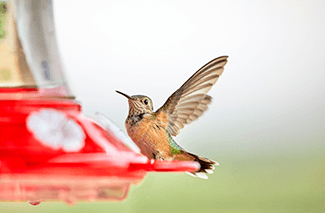
Experiment with retail seeds, feeders, and suet, to get an idea of the wider variety of birds you can attract. Suet is the hard fat around the kidneys and loins in beef and mutton and can safely be fed to birds. It is generally mixed into a block or cake with corn meal, peanuts, fruits, or dried insects. A sock filled with thistle seed can bring a colorful variety of birds into easy view. Be mindful; some seeds and suet may attract pigeons. Start with small quantities and see what you attract.
For hummingbird feeders, the Audubon Society suggests a 1:4 solution of refined white sugar to tap water. That’s ¼ cup of sugar in 1 cup of water. Bring the solution to a boil, then let it cool before filling the feeder. You can make a larger batch and refrigerate the extra solution; remember to bring it to room temperature before refilling the feeder. Note: skip the red dye. The reddening chemicals could be harmful to the birds.
In hot weather, the feeder should be emptied and cleaned twice a week. In cooler weather, once a week. Clean with hot tap water or use a weak vinegar solution. Avoid using dish soaps, as this can leave harmful residue in the feeder.
Adopt A Tortoise
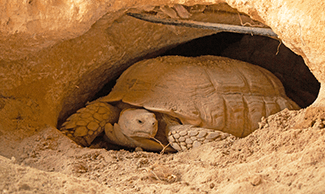
If you live in an area that doesn’t see wildlife beyond butterflies and bees, and you want a “pet” that won’t hog the bed at night, consider adopting a tortoise.
Each year the Arizona Game and Fish Department and the Arizona Sonora Desert Museum adopt out hundreds of captive desert tortoises that are surrendered. These tortoises cannot be released back into the wild because captive tortoises can transmit diseases that can decimate our wild population. Desert tortoises are fascinating animals. They love prickly pear cactus as a den and meal. Be sure to add it to your landscape plan.
Too Close for Comfort
On the flip side, if you don’t want wildlife on your property, feel threatened, or suspect a wild animal may have rabies, contact the Arizona Game & Fish Department. They have extensive resources on living with wildlife, how to deter them from your yard, what to do if you see wildlife, and when to know it’s time to call a game officer.
Otherwise, design a backyard paradise you and the critters can enjoy.
PODCAST
Coming Soon! Tune-in Saturday 9-4-21
Photo Credit
- Shutterstock

